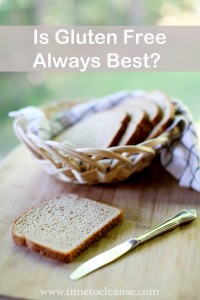 In your quest for a clean lifestyle, you may have decided to eliminate gluten from your diet. You’re probably already aware that many people are sensitive to gluten, and eating it can cause an immune response that results in inflammation. If you suffer from gluten sensitivity or are one of the many people with undiagnosed celiac disease, removing gluten from your diet can be wonderful for your health.
In your quest for a clean lifestyle, you may have decided to eliminate gluten from your diet. You’re probably already aware that many people are sensitive to gluten, and eating it can cause an immune response that results in inflammation. If you suffer from gluten sensitivity or are one of the many people with undiagnosed celiac disease, removing gluten from your diet can be wonderful for your health.
However, while eliminating gluten can have many benefits, a gluten-free diet isn’t always the best diet. A gluten-free diet can lack essential vitamins, minerals, fiber and antioxidants. If your gluten-free foods are processed foods, you could be filling your body with dangerous toxins.
Getting the Right Nutrients
Gluten is found in wheat, barley and rye. With a gluten-free diet, those grains will be off limits. Many people who are gluten sensitive find they can’t eat oats either. If you’ve only been eating refined grains, which can cause blood sugar spikes, you’ll be doing yourself a favor by cutting them out of your diet.
Quiz: Is Your Body TOXIC? Take the Test...
(get your free personalized report)
Eliminating whole grains, however, can cause problems if you aren’t careful. Despite containing gluten, whole grains provide many health benefits. They’re great sources of vitamin E, some B vitamins, and important minerals including iron, phosphorus, zinc, magnesium and selenium. The fiber in whole grains can reduce your risk of cancer, diabetes and heart disease. In addition, whole grains contain antioxidants called phenols.
You can obtain these nutrients and antioxidants from other sources, but you’ll have to make an effort to find them. You can get vitamin E from avocados, kiwifruit, sweet potatoes, papaya and olive oil. You can get B vitamins from spinach, broccoli, milk, eggs, beans, fish, poultry and red meat. Beans, nuts, fish, poultry and red meat contain iron, zinc, phosphorous and selenium.
Eating plenty of fruits and vegetables is a good way to include fiber in your diet.
Quinoa is a fantastic replacement for gluten-rich grains. It has fiber, B vitamins, iron, magnesium and phenols. You can have it for breakfast or use it in a salad instead of pasta.
Gluten-Free and Toxic
So many people have discovered the benefits of a gluten-free diet, that food companies have realized they can make money selling processed gluten-free foods. Once, it was hard to find foods that didn’t contain gluten. Now, you can walk into any supermarket and find shelves full of gluten-free bread, cakes, puddings, doughnuts, pizzas, dressings and sauces. You can buy gluten-free sausages, gluten-free fish sticks and gluten-free ice cream.
Quiz: Is Your Body TOXIC? Take the Test...
(personalized report)
Are these foods really healthy? Not quite.
Gluten-free doesn’t mean sugar-free. Gluten-free doughnuts and cakes can contain lots of sugar. Eating too much sugar can increase your risk of obesity, diabetes, liver disease, stroke, heart disease and cancer.
In fact, gluten-free foods often contain more sugar and fat than the normal versions of those same foods. Many people enjoy the texture and taste that gluten gives foods. Food companies try to make up for this by adding extra fat and sugar, as well as artificial flavors and colors, to their gluten-free products.
To enable these products to maintain their shape, they often replace gluten with additives like xanthan gum and carrageenan. Xanthan gum can cause bloating, flatulence and diarrhea. Studies on rats show that carrageenan might cause colorectal cancer.
As with all packaged food products, gluten-free processed foods can contain artificial preservatives. The addition of preservatives means these products can travel long distances and sit on shelves for a long time.
Keep Eating Clean
With all of the new gluten-free processed foods, it’s easier than ever to grab foods from the supermarket shelf without thinking about what goes into making them.
However, when you switch to gluten-free, the rules for clean eating don’t go out the window.
It’s essential that you continue to read ingredients labels. Look out for added sugar and salt, artificial flavors, artificial colors, preservatives and other additives.
If possible, avoid processed foods altogether. Try to eat organic foods as often as you can.
Make sure your diet is rich in nutrients and antioxidants. Be sure it includes lots of fruits and vegetables.
Pay attention to what you eat, and you’ll enjoy the benefits of a diet that’s both gluten-free and clean.
Additional Sources
The Prevalence of Celiac Disease in the United States, The American Journal of Gastroenterology
Recent advances in the formulation of gluten-free cereal-based products, Food Science and Technology
Review of Harmful Gastrointestinal Effects of Carrageenan in Animal Experiments, Environmental Health Perspectives
The Role of Whole Grains in Disease Prevention, Journal of the American Dietetic Association
